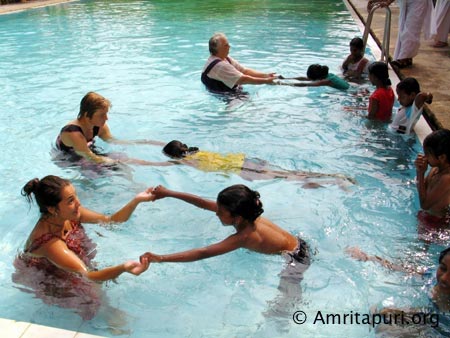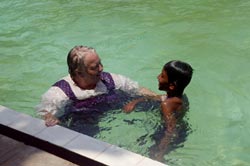15 March 2005 — Amritapuri
It was only a week after the tsunami that Amma first mentioned Her idea of providing swimming lessons for the village children in the Ashram swimming pool. Amma wanted to help the children to overcome their fear of water, as so many had become petrified of Mother Sea since the day she flooded through their streets, washed away their homes and, perhaps, even drowned a friend or family member. “Only through water will they be able to overcome their fear of water,” Amma said.

Now lessons are in full swing, with two one-hour-long classes taking place each morning—one for boys and one for girls. The course, Beginning Swimming & Water Safety, is being taught by Sneha Albione Becnel, a 62-year-old American woman who has lived in Amritapuri for the past five years, during which time she has successfully taught more than 100 people to swim.
“You can’t talk someone out of a fear of water,” says Sneha, a former Red Cross Water Safety Instructor. “However you can teach them skills that will give them control, and that will give them the confidence. That’s what we focus on—things such as getting them to put their face in the water, rhythmic breathing, treading water, bobbing, floating on your stomach and back, the crawl stroke. We also teach them how to do a standing front dive and to jump in feet-first and then swim to safety. We try to get them in water that’s over their head as safely and as quickly as possible.”
Sneha says that the most important thing is to give the children what she calls “buoyancy experiences,” incidents that show them the body’s natural tendency to float. “You can’t teach that with words,” she says. “They must experience it. One thing I like to do is to tell them, ‘Go sit on the bottom of the pool.’ Well, of course, you can’t sit on the bottom of the pool. They find that out and experience the water pushing them up.”

All this helps the children gain confidence. “You have to get them to experience feeling safe in the water,” says Sneha. “All activities we do here are for that purpose.” Once the children overcome their fear, Sneha and her assistants work on getting them mobile in and under the water. “That’s important,” says Sneha. “Just teaching them to swim is not enough. They have to be able to go under water too. That’s a whole different experience. If you can swim, but only with your head above water, it isn’t going to really help you in an emergency.”
The first batch of kids finishes its course on Sunday, and the competent swimmers will all be given certificates to take back home with them. The students who are not quite up to snuff will sit in again with the next batch
Halfway through the course and the children are doing very well, says Sneha, reporting that about 70 percent of the boys can already dive in and then swim to the other side of the pool. “That’s the most rewarding thing: seeing a child who was absolutely terrified of the water when we started—who was afraid to even put her foot in the water—six days later being able to dive in and swim the length of the pool.”
—Tulasi
